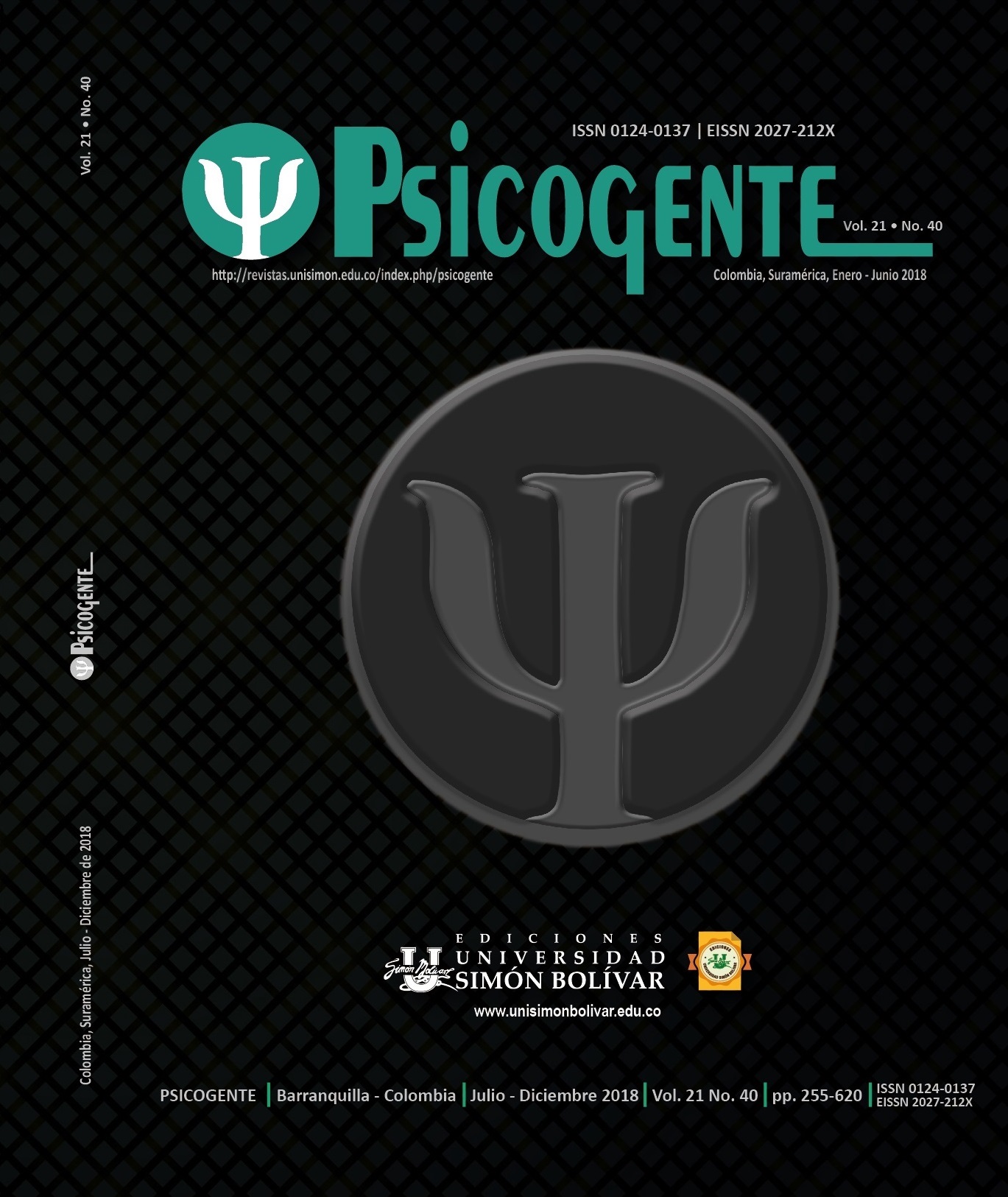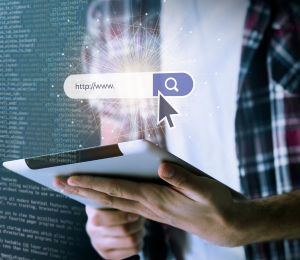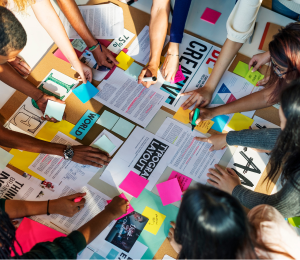Ideación suicida, ansiedad, capital social y calidad de sueño en colombianos durante el primer mes de aislamiento físico por COVID-19
Suicidal ideation, anxiety, social capital, and sleep quality in Colombians during the first month physical isolation by COVID-19
DOI:
https://doi.org/10.17081/psico.24.45.4075Resumen
Objetivo: explorar los niveles de ideación suicida, ansiedad, capital social y calidad de sueño en hombres y mujeres, según edades, en población colombiana durante el primer mes de Aislamiento Físico por pandemia de Covid-19.
Método: Estudio exploratorio y en línea, con 484 sujetos. Se utilizaron cuatro Escalas: Escala de Okasha para Suicidalidad (Okasha-IS), ZungSelf-Rating Anxiety Scale-15 (SAS-15), The Personal Social Capital Scale (PSCS) y Pittsburgh Sleep Quality Index (PSQI). Los instrumentos se registraron en la Web y se suministró mediante WhatsApp, Facebook y E-mail.
Resultados: Se encontró un índice de ideación suicida del 40% entre leve a severa. 97% de ansiedad leve a severa. Capital social personal regular (81%) y 23% con poca calidad de sueño. La edad se asoció de manera inversa con valores de IS, SAS y PSQI (p<0,01) y de manera directa con PSCS (p<0,05). Sexo se correlacionó positivamente con SAS-15 (p<0,01) y PQSI (p<0,05). Mediante Análisis de Varianza se encontró diferencia significativa en hombres en los valores del IS y PQSI (p<0,01) y en mujeres hay diferencia significativa en los valores de IS, SAS-15 y PQSI (p<0,01) en diferentes grupos de edades.
Conclusiones: Las mujeres son más propensas a sentir ansiedad e ideación suicida asociados con Aislamiento Físico y bajo capital social, lo que puede desencadenar problemas psicológicos mayores. Los jóvenes menores de 20 años siguen siendo un grupo de mayor riesgo a padecer psicopatologías profundas, desencadenando suicidios. El presente estudio se adhiere a la idea de usar el término de distanciamiento Físico y no Aislamiento Social, dado que las relaciones sociales se mantienen desde niveles diferentes al contacto físico.
Descargas
Citas
Bahamón, M. J., Alarcón-Vásquez, Y., Reyes Ruiz, L., Uribe Alvarado, J. I., García Galindo, C., &Trejos Herrera, A. M. (2018). Prácticas parentales como predictoras de la ideación suicida en adolescentes colombianos. Psicogente, 21(39), 50-61. https://doi.org/10.17081/psico.21.39.2821
Bandura, A. (1977). Self-efficacy: Toward a unifying theory of behavioral change. Psychol Rev, 84, 191–215. https://doi.org/10.1037//0033-295x.84.2.191
Bayer, C., & Kuhn, M. (2020). Intergenerational ties and case fatality rates: A cross-country analysis. ECONtribute. https://selten.institute/wpcontent/uploads/2020/03/ECONtribute_corona_bayer_kuhn_study_2020.pdf
Berkman, L. F., & Glass, T. (2014). Social integration, social networks, social support, and health. Social epidemiology, 1, 137–173. http://dx.doi.org/10.4135/9781412952576.n192
Berkman, L. F., Glass, T., Brissette, I., &Seeman, T. E. (2000). From social integrationto health: Durkheim in the new millennium. Social Science & Medicine, 51(6), 843–857. https://doi.org/10.1016/S0277-9536(00)00065-4
Bi, O., Wu, Y, Mei, S., Ye, C., Zou, X., Zhang, Z., Liu, X., Wei, L., Truelove, S., Zhang, T., Gao, W., Cheng, C., Tang, X., Wu, X., Wu, Y., Sun, B., Huang, S., Sun, Y., Zhang, Y., Ma, T., Lessler, J., & Feng, T. (2020). Epidemiology and transmission of covid-19 in Shenzhen China: Analysis of 391 cases and 1,286 of their close contacts. medRxiv, reprint https://doi.org/10.1101/2020.03.03.20028423.
Bourdieu, P. (1986). The forms of capital. In J. G. Richardson (Ed.), Handbook of theory and research for the sociology of education (pp. 241–258). Westport, CT: Greenwood Press. http://www.socialcapitalgateway.org/sites/socialcapitalgateway.org/files/data/paper/2016/10/18/rbasicsbourdeu1986-theformsofcapital.pdf
Brooks, S., Webster, R., Smith, L., Woodland, L., Wessely, S., Greenberg, N., & Rubin, G. (2020). The Psychological Impact of Quarantine and How to Reduce It: Rapid Review of the Evidence. The Lancet, 395(10227), 912-920. https://doi.org/10.1016/S01406736(20)30460-8
Brugha, T. (1990). Social networks and social support. CurrOpinPsychiat, 3, 264–68. https://psycnet.apa.org/record/2011-28192-020
Buysse, D., Reynolds, C., Monk, T., Berman, S. & Kupfer, D. (1989). The Pittsburgh sleep quality index: A new instrument for psychiatric practice and research. Psychiatry Research, 28(2), 193-213. https://doi.org/10.1016/0165-1781
Cai, H., Tu, B., Ma., Chen, L., Fu, L., Jiang, Y., &Zhuang. (2020). Psychological Impact and Coping Strategies of Frontline Medical Staff in Hunan Between January and March 2020 During the Outbreak of Coronavirus Disease 2019 (COVID19) in Hubei,
China. Med SciMonit, 26, e924171. https://doi.org/10.12659/MSM.924171
Coleman, J. S. (1988). Social capital in the creation of human capital. American Journal of Sociology, 94(S1), S95–S120. https://doi.org/10.1086/228943 .
Chen, X., Stanton, B., Gong, J., Fang, X., & Li, X. (2009). Personal Social Capital Scale: An instrument for health and behavioral research. Health Education Research, 24(2), 306–317. https://doi.org/10.1093/her/cyn020
Chen, X., Zhang, Y., & Xu, X. (2019). The mediating effects of anxiety, self-efficacy and sleep quality on the relationship between doctor-patient’s empathy and inflammatory marker in patients with ulcerative colitis. Med SciMonit, 25, 7889–97. https://doi.org/10.12659/MSM.917552
Cacioppo, J. T., Hawkley, L. C., Crawford, L. E., Ernst, J. M., Burleson, M. H., Kowalewski, R. B., … Berntson, G. G. (2002). Loneliness and health: Potential mechanisms. Psychosomatic Medicine, 64(3), 407–417. https://www.ncbi.nlm.nih.gov/pubmed/12021415
Dahlgren, A., Kecklund, G., &Akerstedt, T. (2005). Different levels of work-related stress and the effects on sleep, fatigue and cortisol. Scand J Work Environ Health, 31, 277–285. https://www.jstor.org/stable/40967503?seq=1
de Jong Gierveld, J., & Havens, B. (2004). Cross-nationalcomparisons of social isolation and loneliness: Introduction and overview. Canadian JournalonAging, 23(2), 109–113. https://doi.org/10.1353/cja.2004.0021
De Silva, M. J., McKenzie, K., Harpham, T., &Huttly, S. R. (2005). Social capital and mental illness: A systematic review. Journal of Epidemiology and Community Health, 59(8), 619–627. https://doi.org/10.1136/jech.2004.029678.
Gao, J., Zheng, P., Jia, Y., Chen, H., Mao, Y., Chen, S., Wang, Y., Fu, H., & Dai, J. (2020). Mental Health Problems and Social Media Exposure During COVID-19 Outbreak. The Lancet, Available at SSRN: http://dx.doi.org/10.2139/ssrn.3541120
Guo, J. Liao, L., Wang, B., Li, X., Guo, L., Tong, Z., Guan, Q., Zhou, M., Wu, Y., Zhang, J., &Gu, Y. (2020). Psychological Effects of COVID-19 on Hospital Staff: A National Cross-Sectional Survey of China Mainland. The Lancet,Available at SSRN http://dx.doi.org/10.2139/ssrn.3550050
Guruge, S., Thomson, M., George, U., &Chaze, F. (2015). Social support, social conflict, and immigrant women’s mental health in a Canadian context: a scoping review.J PsychiatrMent Health Nurs. Nov22(9):655-67. https://doi.org/10.1111/jpm.12216.
Harpham, T., Grant, E., & Thomas, E. (2002). Measuring social capital within health surveys: Key issues. Health Policy and Planning, 17(1), 106–111. https://doi.org/10.1093/heapol/17.1.106.
Harpham, T., Grant, E., & Rodriguez, C. (2017). Mental health and social capital in Cali, Colombia. SocSci Med, 2004; 58(11): 2267–2277. https://doi.org/10.1016/j.socscimed.2003.08.013
Hawkley, L. C., &Cacioppo, J. T. (2010). Loneliness matters: A theoretical and empirical review of consequences and mechanisms. Annals of Behavioral Medicine, 40(2), 218–227. https://doi.org/10.1007/s12160-010-9210-8
Holst-Algren., M, Ekholm, O., Nielsen, L., Kjær-Ersbøll, A., Kronborg-Bak, C., &Tanggaard-Andersen, P. (2020). Social isolation, loneliness, socioeconomic status, and health-risk behaviour in deprived neighbourhoods in Denmark: A cross-sectional study. SSM - PopulationHealth, 10 (2020), 1-9. https://doi.org/10.1016/j.ssmph.2020.100546
Holt-Lunstad, J., Smith, T. B., Baker, M., Harris, T., & Stephenson, D. (2015). Loneliness and social isolation as risk factors for mortality: A meta-analytic review. Perspectives on Psychological Science, 10(2), 227–237. https://doi.org/10.1177/1745691614568352
Kaiser, H. F. (1974). An index of factorial simplicity. Psychometrika, 34, 31-36. https://doi.org/10.1007/BF02291575
Kaplan, G. A., Lazarus, N. B., Cohen, R. D., & Leu, D. J. (1991). Psychosocialfactors in the natural history of physical activity. American Journal of Preventive Medicine, 7(1), 12–17. https://www.ncbi.nlm.nih.gov/pubmed/1867895
Kent de Grey, R., Uchino, B., Trettevik, R., Cronan, S., & Hogan, J.N. (2018). Social support and sleep: A meta-analysis. Health Psychol, 37, 787–98. https://doi.org/10.1037/hea0000628
Khazaeian, S., Kariman, N., Ebadi, A., &Nasiri, M. (2017) The impact of social capital and social support on the health of female-headed households: a systematic review. Electron Physician, 9(12), 6027–6034. https://doi.org/10.19082/6027
Lange, T., Dimitrov, S., & Born, J. (2010). Effects of sleep and circadian rhythm on the human immune system. Ann NY AcadSci, 1193: 48–59. https://www.jimmunol.org/content/158/9/4454.long
Leung, G., Lam, T., Ho., L., Ho, S.Y., Chan, B,H., Wong, I.O., & Hedley, A.J. (2003). The impact of community psychological responses on outbreak control for severe acute respiratory syndrome in Hong Kong. J Epidemiol Community Health, 57(11), 857 – 63. https://doi.org/10.1136/jech.57.11.857
Liu, C., Yang, Y., Zhang, X., Xu, X., Dou, Q., & Zhang, W. (2020). The Prevalence and Influencing Factors for Anxiety in Medical Workers Fighting COVID-19 in China: A Cross-Sectional Survey. The Lancet, Available at SSRN: http://dx.doi.org/10.2139/ssrn.3548781
Liu, D., Ren, Y., Yan, F., Li, Y., Xu, X., Yu, X., Qu, W., Wang, Z. Tian, B. Yang, F., Yao, Y., Tan, Y., Jiang, R., & Tan, S. (2020). Psychological impact and predisposing factors of the 2019 coronavirus disease pandemic (COVID-19) on the general public in China. The Lancet, Available at SSRN: http://dx.doi.org/10.2139/ssrn.3551415
Liu, X., Liu, J., & Zhong, X. (2020). Psychological State of College Students During COVID-19 Epidemic. The Lancet, Available at SSRN: http://dx.doi.org/10.2139/ssrn.3552814
Liu, Y., Eggo, R., &Kucharski, A. (2020). Secondary attack rate and superspreading events for sars-cov-2. The Lancet. 395, https://doi.org/10.1016/S0140-6736(20)30462-1
Locher, J. L., Ritchie, C. S., Roth, D. L., Baker, P. S., Bodner, E. V., & Allman, R. M. (2005). Social isolation, support, and capital and nutritionalrisk in anoldersample: Ethnic and genderdifferences. Social Science & Medicine, 60(4), 747–761. https://doi.org/10.1016/j.socscimed.2004.06.023
Lynch, W., & Kaplan, GA. (1997). Understanding how inequality in the distribution of income affects health. J Health Psychol. 2(3), 297–314. https://doi.org/10.1177/135910539700200303
Machado-Duque, M., Echeverri-Chabur, J., & Machado-Alba, J. (2015). Somnolencia diurna excesiva, mala calidad del sueño y bajo rendimiento académico en estudiantes de Medicina. Revista Colombiana de Psiquiatría, 44(3), 137-142. https://doi.org/10.1016/j.rcp.2015.04.002
McDonald, K (2018). Social support and mental health in LGBTQ adolescents: A review of the literature. Issues Ment Health Nurs, 39(1), 16 – 29. https://doi.org/10.1080/01612840.2017.1398283
Mehnert, A., lehmann, C., Graefen, M., Huland, H., & Koch, U. (2010). Depression, anxiety, post‐traumatic stress disorder and health‐related quality of life and its association with social support in ambulatory prostate cancer patients. European Journal of Cancer Care. 19, 736–745. https://doi.org/10.1111/j.1365-2354.2009.01117.x
Mossong, J., Hens, N., Jit, M., Beutels, P., Auranen, K., Mikolajczyk, R., Massari, M., Salmaso, S., Scalia-Tomba, G., Wallinga, J., Heijne, J., Sadkowska-Todys, M., &Rosinska, M. (2008), “Social contacts and mixing patterns relevant to the spread of infectious diseases”, PLoS Medicine 5(3). https://doi.org/10.1371/journal.pmed.0050074
Niño, J., Barragán, M., Ortiz, J., Ochoa, M., & González., H. (2018). Factores asociados con somnolencia diurna excesiva en estudiantes de Medicina de una institución de educación superior de Bucaramanga. RevistaColombiana de Psiquiatría, (260), 1-10. https://doi.org/10.1016/j.rcp.2017.12.002
Okasha, A., Lotaif, F., &Sadek, A. (1981). Prevalence of suicidal feelings in a sample of nonconsulting medical students. Acta PsychiatrScand, (63), 409-415. Recuperado de https://www.ncbi.nlm.nih.gov/pubmed/7315487
Peng, E:, Lee., M., Tsai, S., Yang, C.C., Morisky, D.E., Tsai, L.T., Weng, Y.L., & Lyu, S.Y. (2010). Population-based post-crisis psychological distress: An example from the SARS outbreak in Taiwan. J Formos Med Assoc, 109, 524–32. https://doi.org/10.1016/S0929-6646
Peplau, L. A., & Perlman, D. (1982). Loneliness: A sourcebook of currenttheory, research, and therapy. New York: Wiley.
Perissinotto, C. M., &Covinsky, K. E. (2014). Living alone, sociallyisolatedorlonely– what are wemeasuring?. Journal of General Internal Medicine, 29(11), 1429–1431. https://doi.org/10.1007/s11606-014-2977-8
Portes, A. (1998). Social capital: Its origins and applications in modern sociology. Annu Rev Soc, 24(1), 1 – 24. https://www.annualreviews.org/doi/abs/10.1146/annurev.soc.24.1.1
Prati, G., & Pietrantoni, L. (2010): The relation of perceived and received social support to mental health among first responders: A meta-analytic review. J Community Psychol, 2010; 38(3): 403–17. https://doi.org/10.1002/jcop.20371
Prichard, J., & Hartmann, M. (2019). Follow-up to Hartmann & Prichard: Should universities invest in promoting healthy sleep? A question of academic and economic significance. Sleep Health, 5(4), 320-325. https://doi.org/10.1016/j.sleh.2019.01.006
Putnam, R. D. (1995). Tuning in, tuning out: The strange disappearance of social capital in America. Political Science and Politics, 28(4), 664–683. https://doi.org/10.2307/420517.
Rodríguez, U., Rodrigues-deFrança Campos, F., Chionbacanga-Nafital , A., Ceballos- Ospino, G., &Paba-Barbosa , C. (2019). Las inteligencias, emociones y cronotipo, ¿explican el desempeño académico en universitarios?. Educación Y Humanismo, 22(38), 1-21 https://doi.org/10.17081/eduhum.22.38.3636
Shankar, A., McMunn, A., Banks, J., &Steptoe, A. (2011). Loneliness, social isolation, and behavioral and biologicalhealthindicators in olderadults. HealthPsychology, 30 (4), 377–385. https://doi.org/10.1037/a0022826
Sohrabia, C., Alsafib, Z., O’Neilla, N., Khanb, M., Kerwanc, A., Al-Jabirc, A., Iosifidisa, C., &Aghad, R. (2020). World Health Organization declares global emergency: A review of the 2019 novel coronavirus (COVID-19). International Journal of Surgery, 76 (2020), 71–76. https://doi.org/10.1016/j.ijsu.2020.02.034
Weyers, S., Dragano, N., Mobus, S., Beck, E. M., Stang, A., Mohlenkamp, S., …Siegrist, J. (2010). Poor social relations and adverse healthbehaviour: Strongerassociations in lowsocioeconomicgroups?. International Journal of Public Health, 55(1), 17–23. https://doi.org/10.1007/s00038-009-0070-6
Xiao, H., Zhang, Y., Kong, D., Li, S., & Yang, N. (2020A).Social Capital and Sleep Quality in Individuals Who Self-Isolated for 14 Days During the Coronavirus Disease 2019 (covid-19) Outbreak in January 2020 in China. Med SciMonit, 26, e923921. https://doi.org/10.12659/MSM.923921
Xiao, H., Zhang, Y., Kong, D., Li, S., & Yang, N. (2020B).The Effects of Social Support on Sleep Quality of Medical Staff Treating Patients with Coronavirus Disease 2019 (COVID-19) in January and February 2020 in China. Med SciMonit, 26, e923549. https://doi.org/10.12659/MSM.923549
Yao, K., Yu, S., Cheng, S., & Chen, I. (2008). Relationships between personal, depression and social network factors and sleep quality in community-dwelling older adults. J Nurs Res, 16, 131–139. https://doi.org/10.1097/01.JNR.0000387298.37419.ff
Yuan, S., Liao, Z., Huang, H., Jiang, B., Zhang, X., Wang, Y., & Zhao, M. (2020). Comparison of the Indicators of Psychological Stress in the Population of Hubei Province and Non-Endemic Provinces in China During Two Weeks During the Coronavirus Disease 2019 (COVID-19) Outbreak in February 2020. Med SciMonit, 26, e923767. https://doi.org/10.12659/MSM.923767
Zhu, J., Sun, L., Zhang, L., Wang, H., Fan, A., Yang, B., Xiao, S., & Li, W. (2020). Prevalence and influence factors of anxiety and depression symptoms in front-line medical personnel fighting against COVID-19 in Gansu. The Lancet, Available at SSRN: http://dx.doi.org/10.2139/ssrn.3550054
Zung, W. (1971). A R.ating Instrument For Anxiety Disorders. Psychosomatics, 12(6), 371-379. https://doi.org/10.1016/S0033-3182(71)71479-0
Descargas
Publicado
Cómo citar
Número
Sección
Licencia
Derechos de autor 2021 Ubaldo Enrique RodrÃguez, Zumeina Lucía León Valle, Guillermo Augusto Ceballos Ospino

Esta obra está bajo una licencia internacional Creative Commons Atribución 4.0.
Desde la revista Psicogente impartimos una política de respeto con nuestra comunidad científica incluyendo a nuestros autores. Los autores tienen derecho a un trato respetuoso y atento en el proceso Editorial, que las evaluaciones de sus artículos sean justas, imparciales (para ello la revista procederá con la evaluación doble ciego) y se realicen en un tiempo razonable. Se deberá mantener la confidencialidad y los permisos para proceder con la publicación. Todo cambio solicitado por parte del comité, los pares y el Editor deberán ser explícitos y claramente justificados. Especifica que los autores/as conservarán sus derechos de autor y garantizarán a la revista el derecho de primera publicación de su obra, el cual estará simultáneamente sujeto a la Licencia de reconocimiento de Creative Commons BY que permite a terceros compartir la obra siempre que se indique su autor y su primera publicación a esta revista.
Garantizamos un proceso editorial transparente: desde las acciones de recepción del articulo hasta la validación final del mismo, se hará en comunicación constante con el autor. Las modificaciones en el estado de los artículos, así como las diversas decisiones tomadas sobre él y los tiempos de ejecución empleados se realizarán haciendo uso de la plataforma OJS y de ser necesario en contacto directo a través del correo de autores y de la revista Psicogente. Así mismo se procura la escogencia de Pares revisores idóneos: con perfiles y experiencia que lleven a una avaluación de calidad de cada documento sometido a revisión.






